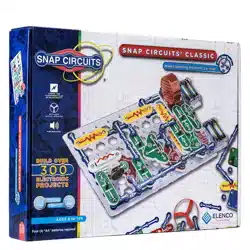Loading ...
Loading ...
Loading ...

9
After building the circuits given in this booklet, you may wish to experiment on your
own. Use the projects in this booklet as a guide, as many important design concepts
are introduced throughout them. Every circuit will include a power source (the batteries),
a resistance (which might be a resistor, lamp, motor, integrated circuit, etc.), and
wiring paths between them and back.
You must be careful not to create "short circuits"
(very low-resistance paths across the batteries, see examples below) as this will
damage components and/or quickly drain your batteries.
Only connect the ICs using
congurations given in the projects, incorrectly doing so may damage them. Elenco
®
is
not responsible for parts damaged due to incorrect wiring.
You are encouraged to tell us about new circuits you create. If they are
unique, we will post them with your name and state on our website at
www.elenco.com/for-makers. Send your suggestions to
Elenco
®
provides a circuit designer so that you can make your own
Snap Circuits
®
drawings. This Microsoft
®
Word document can be
downloaded from www.elenco.com/for-makers.
Examples of SHORT CIRCUITS - NEVER DO THESE!!!
WARNING: SHOCK HAZARD - Never connect Snap Circuits
®
to
the electrical outlets in your home in any way!
DOs and DON’Ts of Building Circuits
Placing a 3-snap wire
directly across the batteries
is a SHORT CIRCUIT.
This is also a
SHORT CIRCUIT.
When the slide switch (S1) is turned on, this large circuit has a SHORT
CIRCUIT path (as shown by the arrows). The short circuit prevents any
other portions of the circuit from ever working.
NEVER
DO!
!
NEVER
DO!
!
!!
NEVER
DO!
NEVER
DO!
Here are some important guidelines:
ALWAYS USE EYE PROTECTION WHEN EXPERIMENTING ON YOUR OWN.
ALWAYS include at least one component that will limit the current through a circuit,
such as the speaker, lamp, whistle chip, capacitors, ICs (which must be
connected properly), motor, microphone, photoresistor, or resistors (the
adjustable resistor doesn’t count if it’s set at/near minimum resistance).
ALWAYS use transistors, the high frequency IC, the antenna, and switches in
conjunction with other components that will limit the current through them.
Failure to do so will create a short circuit and/or damage those parts.
ALWAYS connect the adjustable resistor so that if set to its 0 setting, the current
will be limited by other components in the circuit.
ALWAYS connect position capacitors so that the “+” side gets the higher voltage.
ALWAYS disconnect your batteries immediately and check your wiring if something
appears to be getting hot.
ALWAYS check your wiring before turning on a circuit.
ALWAYS connect ICs using congurations given in the projects or as per the
connection descriptions for the parts.
NEVER try to use the high frequency IC as a transistor (the packages are similar,
but the parts are different).
NEVER use the 2.5V lamp in a circuit with both battery holders unless you are sure
that the voltage across it will be limited.
NEVER connect to an electrical outlet in your home in any way.
NEVER leave a circuit unattended when it is turned on.
NEVER touch the motor when it is spinning at high speed.
Warning to Snap Circuits
®
owners: Do not connect additional
voltage sources from other sets, or you may damage your parts.
Contact ELENCO
®
if you have questions or need guidance.
!
For all of the projects given in this book, the parts may be arranged in different ways
without changing the circuit. For example, the order of parts connected in series or in
parallel does not matter — what matters is how combinations of these sub-circuits are
arranged together.
Loading ...
Loading ...
Loading ...
